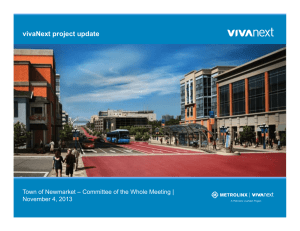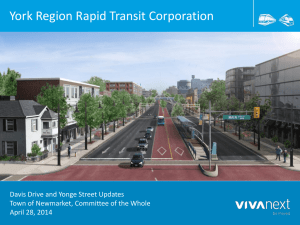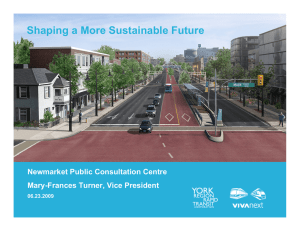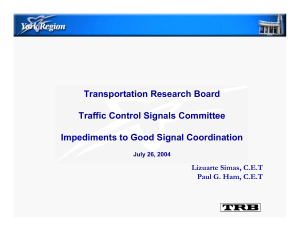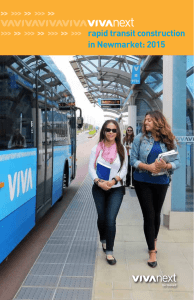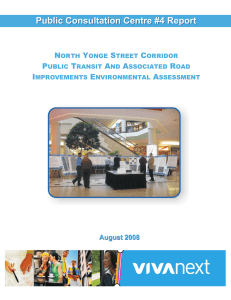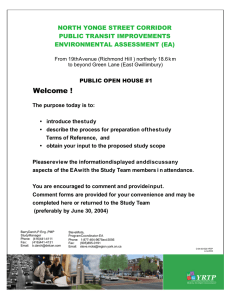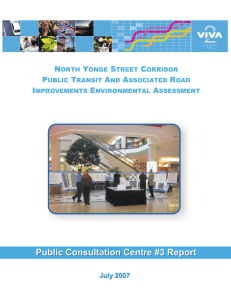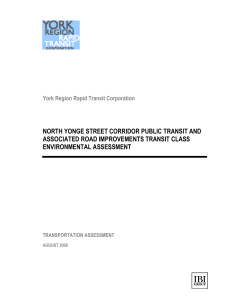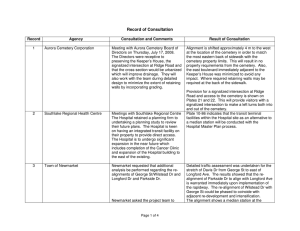Welcome....
advertisement
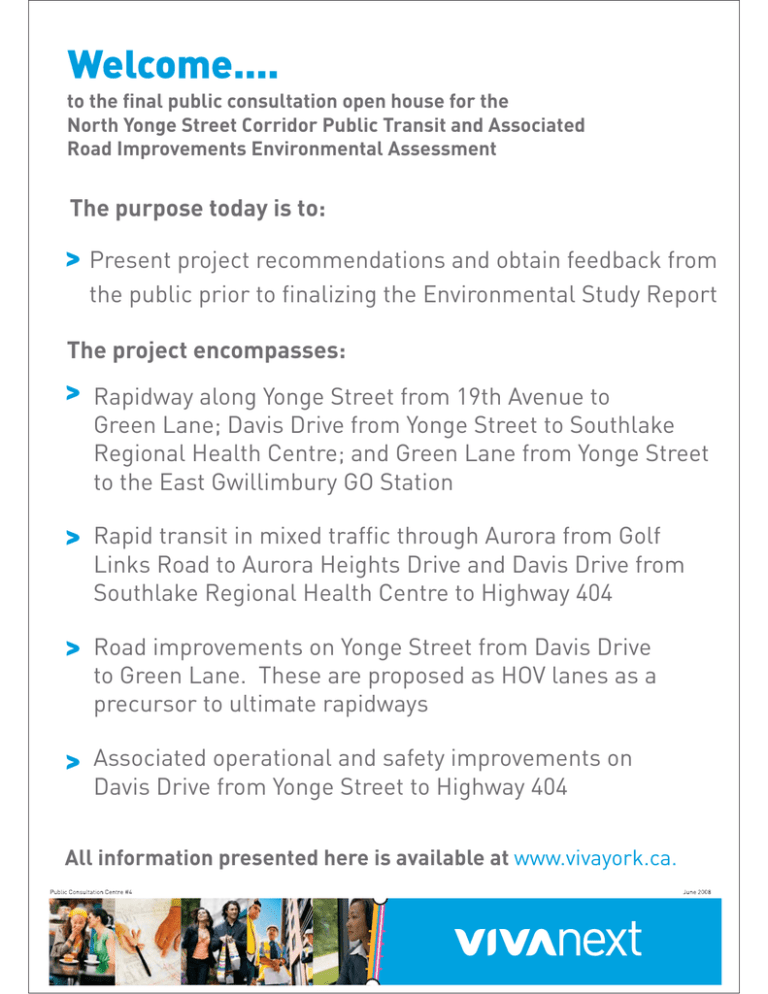
Welcome.... to the final public consultation open house for the North Yonge Street Corridor Public Transit and Associated Road Improvements Environmental Assessment The purpose today is to: Present project recommendations and obtain feedback from the public prior to finalizing the Environmental Study Report The project encompasses: Rapidway along Yonge Street from 19th Avenue to Green Lane; Davis Drive from Yonge Street to Southlake Regional Health Centre; and Green Lane from Yonge Street to the East Gwillimbury GO Station Rapid transit in mixed traffic through Aurora from Golf Links Road to Aurora Heights Drive and Davis Drive from Southlake Regional Health Centre to Highway 404 Road improvements on Yonge Street from Davis Drive to Green Lane. These are proposed as HOV lanes as a precursor to ultimate rapidways Associated operational and safety improvements on Davis Drive from Yonge Street to Highway 404 All information presented here is available at www.vivayork.ca. Environmental Assessment Process: Where We Are Problem Statement Base Map Preparation Describe Undertaking from background studies (Transportation Master Plan) MOE Approval of ToR Identify Alternatives to the Undertaking (Alt. Strategies) Existing Conditions Describe & Analyse Alternative Strategies Evaluation of Alternative Strategies Select Preferred Alternative Strategy Identify Alternative Methods of carrying out the Undertaking EA Open House # 2 September 2006 Terms of Reference (ToR) Open House # 1 June 2004 Establish Planning & Design Criteria Prepare and Submit Terms of Reference to Ministry of Environment (MOE) Outline EA Work Plan Update Existing Conditions Develop Alternative Methods (Design) Develop Evaluation Criteria August 2005 EA Open House # 3 June 2007 Integration of Davis Drive Class EA Transition to Transit Class EA Assessment of Effects of Alternative Designs Evaluation of Alternative Designs Select preferred Design Today EA Open House # 4 June 2008 Refine preferred Alternative Design Complete ESR ESR placed on public record for 30 days (late summer 2008) Opportunities for public input Project Approved and moves to Design Phase Assessment of effects of Preferred Design Viva Network Map Existing Social/Cultural Environment & Land Use Existing Natural Environment Town of Newmarket Note: Sourced from the Town of Newmarket Official Plan 2006- 2026 Town of East Gwillimbury Note: Sourced from the Proposed Urban Structure Plan, Town of East Gwillimbury Preferred Routing N GO Tra n sit Ba rrie Lin e Widened to 6 lanes (Interim HOV Lanes with ultimate conversion to dedicated median rapidway) Legend: Station Mixed Traffic Widened to 6 lanes Dedicated Median Rapidway Yonge Street Bloomin gton Roa d Typical Cross-Sections 40 -45 m ROW - dedicated median rapidway with bike lanes on Yonge Street and Green Lane 36 m ROW - dedicated median rapidway on Davis Drive 42.6 m ROW - 6 lane widening on Yonge Street between Davis Drive and Green Lane (interim stage with HOV lanes) Cross-Section Source: “Towards Great Regional Streets: A Path to Improvement”, York Region Constrained Cross-Sections Under GO Transit Rail Bridge north of Industrial Parkway in Aurora Note: Sidewalk and bike path located in new underpass through embankment on east side West East New Keith Bridge on Davis Drive over East Holland River in Newmarket 33.8m New bridge width (inside railings) East Holland River Davis Drive Operational Improvements Wilstead Drive Re-alignment – Desirable ultimate scenario – Facilitated by the Town of Newmarket through future land redevelopment and site plan approval process – Not included in undertaking of EA Parkside Drive Re-alignment – Necessary due to close intersection spacing of Parkside Drive and Longford Drive – Permits standard station design – Traffic operations will be safer with one signalized intersection versus the two existing signals – Included in the undertaking of the EA Advantages of the Project • A four corridor network providing a fast, frequent and reliable transit alternative with good connections to local and GO Transit services • Convenient, safe access to station platforms for all passengers Built in Mitigation Natural Environment Protection • Placing the preferred rapidway alignment mostly in existing road right-of-way to limit the effects on creeks with bridge or culvert widening. • Doubling transit use in the Corridor to add to the anticipated improvement in air quality levels due to the lower emissions from improved automobile technology. • Replacement of the East Holland River bridge will include treatments that mitigate any effects on the watercourse. Community and Economic Benefits • Rapidway implementation can help shape revitalization and be a catalyst for the enhancement of streetscapes, creating a more attractive pedestrian-oriented environment. • Corridor road lane capacity maintained or increased where necessary and access to adjacent properties facilitated by dedicated signal phase for left and U-turns. • Transit routes reinforcing the Region's Centres and Corridors land use policy and encouraging transit-oriented development at key station nodes. Summary of Key Effects & Mitigation Strategy Issue/impact: Left turn traffic will only be allowed to cross the rapidway at signalized intersections. Access to and from driveways will be affected. Mitigation: U-turns will be permitted at signalized intersections with dedicated signal phase. Issue/impact: The proposed limits of the project are wider than the existing road allowance in some areas. Additional property will be required from affected landowners. Mitigation: York Region will acquire property from affected landowners through purchase or dedication as lands develop or re-develop. Issue/impact: The project may affect some properties regarding existing landscaping, signage on-site traffic circulation and parking. Mitigation: York Region will work with affected owners and tenants during the design phase to minimize site impacts. In exceptional cases, the mitigation strategy may include up to and including full buy-out and business relocation, which will be investigated with each significantly affected landowner. Issue/impact: The project will require widening or replacement of structures over watercourses. There may be potential impact to the watercourse and adjacent vegetation. Mitigation: York Region will work with the affected stakeholders during the design phase to acquire the necessary approvals. The design will include specific mitigation to minimize impacts. What Happens Next? The next stages of the EA process involves: Consider input received from this Public Open House Refinement of the preferred design for rapidways and road improvements Prepare and circulate the Environmental Study Report (ESR) to obtain agency comments Finalize the ESR and make it available for a 30 day public review period We encourage you to provide comments so that your ideas and concerns can be considered during the preparation of the ESR.
